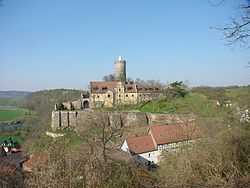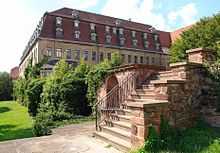House of Schönburg
Schönburg (also Schumburg; Czech: ze Šumburka) is the name of an old noble house, formerly with properties in present day Saxony, Thuringia and Bohemia.
History
For several hundred years the lords of Schönburg (Saale) have appeared in the history of southwestern Saxony, beginning in 1130, with the mention of Ulricus de Schunenberg (also Sconenberg).[1]
Expansion of the house
The lords of Schönburg acquired several possessions over the centuries: Glauchau, where they had built a castle as an imperial fief around 1170, came into their ownership in 1256. They owned Lichtenstein since 1286, Waldenburg since 1378, the county of Hartenstein since 1406 and the lordships of Penig and Wechselburg since 1543. They received the lordship of Rochsburg Castle in 1548 in trade for Lohmen, Wehlen, Hohnstein and Kriebstein.
-

Schönburg (Saale) Castle
-
Glauchau, Forderglauchau Castle
-

Glauchau, Hinterglauchau Castle
-
Lichtenstein Castle
-
.jpg)
Waldenburg Castle
-

Hartenstein Castle
-

Stein Castle in Hartenstein
-

The Old Castle at Penig
-

Wechselburg Castle
Jurisdiction and privileges
The territory of Schönburg overlapped into Saxony, Bohemia, and eventually Thuringia and all of it fell under the legal jurisdiction of the Holy Roman Empire of the German Nation. Consequently, the lords of Schönburg had different status in different areas under their possession, depending on whether there was over-lordship, and to whom. They were counted among the noble estates of the Holy Roman Empire of the German Nation, and to the landed estates in the Kingdom of Saxony. For their estates in the Kingdom of Bohemia, the counts of Schönburg were members of the Imperial College. On 7 August 1700, the collective house was raised to the status of Reichsgrafstand, or imperial county: its branches were consequently raised in status one and all .[2] With this, members of the house received the predicate Illustrious Highness. The honor carried an important implication: the lordship was allodial, not a fief, thus the title, to the property and to the status, was inalienable (it could not be taken away). An allodial territory was a territory for which no feudal contract existed. It was subject to the emperor as sovereign but not to the emperor as overlord. Finally, at his coronation 9 October 1790, Leopold II raised the Waldenburg-Hartenstein branch of the family to the status of a princely house.[3]
Mediatization 1803 and 1806
After the Reichsdeputationshauptschluss in 1803, with many others of the nobility, the members of the house were named as Standesherren, and the family with once sovereign territorial lordship had to forfeit its judicial and legal rights, but retained its social and cultural standing as a sovereign family mediatized to Saxony. In 1818, the House petitioned the German Confederation to recognize the family; in 1828 the Parliament vouchsafed the personal and family rights that had been abrogated in 1806. The House was granted two seats in the Upper House of the Kingdom of Saxony in 1831. In 1878 they lost their last rights of partial sovereignty, however the King of Saxony decreed that all members of the family were to be known as Illustrious Highness.[4]
The branches still today existing are the princes of Schönburg-Waldenburg (devided into the side branches Droyßig, Guteborn/Gusow and Gauernitz), the princes of Schönburg-Hartenstein (at Hartenstein, Stein and Lichtenstein) and the counts of Schönburg-Glauchau (formerly owning Glauchau, Penig, Wechselburg and Rochsburg).
Territories
The property over time has expanded to 15 square miles (39 km2). The same space today has 14 communities and 61,000 residents. The largest portion was a Saxon fiefdom.
Changes in status
In 1569, the lordship was partitioned into Upper and Lower Schönburg. In 1700, Upper Schönburg was raised to the status of a county. At a meeting of the Saxon estates in 1740, Saxony assumed legal and military guardianship of the Schönburg lordship and over the next decade the estate was integrated into the Saxon legal and judicial structure.[5] The old Upper Schönburg was partitioned to Schönburg-Hartenstein and Schönburg-Waldenburg in 1700.
The Soviet-directed agrarian land reform of September 1945 limited the size of any property, generally, to 1 square kilometer (0.39 sq mi). The Schönburg estates were confiscated, along with nearly 30,000 square kilometers (12,000 sq mi) of other land and property. After the German reunification, prince Alfred of Schönburg-Hartenstein (b. 1953) bought back Stein Castle in Hartenstein and Lichtenstein Castle. In 2008 he became president of the Association of the German Nobility.
Bohemian possessions
The Bohemian possessions included Údlice (Eidlitz), Ahníkov (Hagensdorf), Hasištejn (Hassenstein), Perštejn (Pürstein), Kadaň (Kaaden), Žacléř (Schatzlar), Trutnov (Trautenau) and Šumburk (Schönburg).
Saga of the Coat of Arms
The origins of the family crest are not documented. According to "legend,"
...in the last battle, Charlemagne was hard-pressed against the Saxon Duke Wettekind. Most of his followers had already fallen, only he alone resisted the onslaught of the enemy. Suddenly, one of them struck his shield with a stone-like fist and it splintered into pieces. Charlemagne had only his sword for his defense. One of his fallen companions lifted his shield for Charlemagne’s defense. Immediately after the battle was won, Charlemagne discovered that the man who saved him had survived, and recognized him as a Schönburg. Charlemagne took a simple silver shield without markings. Using three finger--his ring, middle and pointing finger of his right hand--which was wounded and bloody, he stroked twice over the silver shield, so that there were two red stripes, and said, “Schönburg, this is from now forward your Mark, blood on the Coat of arms of your house.[6]
Partial list of the Name bearers
- Friedrich von Schönburg (died 1312), Count of Kaaden
- Adelheid von Dohna (died 15 June 1342/52), born von Schönburg-Glauchau, Countess, Wife of Otto (Heide)
- Alois Fürst von Schönburg-Hartenstein (1858–1944), Austrian lieutenant general
- Princess Sophie of Schönburg-Waldenburg and Albania (1885–1936), born Princess von Schönburg-Waldenburg and after Princess of Albania.
- Joachim, Count von Schönburg-Glauchau (1929–1998), writer, CDU member of the Bundestag 1990–1994
- Gloria, Countess of Schönburg-Glauchau, Princess of Thurn and Taxis (born 1960)
- Alexander, Count von Schönburg-Glauchau (born 1969), German journalist and writer
- Christoph, Count von Schönburg-Glauchau (born 1962), Federal prize winner (films) 2005, sound designer of the Oscar-winning film "The Lives of Others" (2007)
Literature
- Enno Bünz (2007), "Schönburg, von", Neue Deutsche Biographie (NDB) (in German) 23, Berlin: Duncker & Humblot, pp. 399–401
- Konrad Müller: Schönburg. Die Geschichte des Hauses bis zur Reformation, Leipzig 1931.
- Matthias Frickert: Die Nachkommen des 1. Fürsten von Schönburg. Klaus Adam, Glauchau 1992.
- Heinrich Graesse: Deutsche Adelsgeschichte. Reprint-Verlag, Leipzig 1999 (Reprint d. Ausg. von 1876), ISBN 3-8262-0704-1.
- Hermann Grote: Herren, Grafen und Fürsten von Schönburg, in: Stammtafeln mit Anhang, Calendarium medii aevi, S. 252 f., Leipzig 1877, Nachdruck: ISBN 3-921695-59-7.
- Adolph Grützner: Monographie über das fürstliche und gräfliche Haus Schönburg. Leipzig 1847.
- Otto Posse: Die Urahnen des Fürstlichen und Gräflichen Hauses Schönburg. Dresden 1914.
- Walter Schlesinger: Die Schönburgischen Lande bis zum Ausgang des Mittelalters. Schriften für Heimatforschung 2, Dresden 1935.
- Walter Schlesinger: Die Landesherrschaft der Herren von Schönburg. Eine Studie zur Geschichte des Staates in Deutschland. Quellen und Studien zur Verfassungsgeschichte des Deutschen Reiches in Mittelalter und Neuzeit IX/1, Böhlau, Münster/Köln 1954.
- Theodor Schön: Geschichte des Fürstlichen und Gräflichen Gesamthauses Schönburg. Urkundenbuch Bd. 1-8, Nachtragsband. Stuttgart/Waldenburg, 1901ff.
- Michael Wetzel: Schönburgische Herrschaften. Beiheft zur Karte C III 6 des Atlas zur Geschichte und Landeskunde von Sachsen. Leipzig/Dresden 2007, ISBN 978-3-89679-610-3.
- Genealogisches Handbuch des Adels, Adelslexikon Band XIII, Band 128 der Gesamtreihe, C. A. Starke Verlag, Limburg (Lahn) 2002, ISSN 0435-2408
- Joachim Bahlcke u. a.: Handbuch der historischen Stätten Böhmen und Mähren, Kröner-Verlag, Stuttgart 1998, ISBN 3-520-32901-8, S. 864.
- Johann Georg Theodor Grässe: Geschlechts-, Namen- und Wappensagen des Adels deutscher Nation, Verlag Schönfeld, 1876, S. 142–143.
Citations
- ↑ Codex diplom. saxon. I, 2, Nr. 83 und Dobenecker, Regesta histor. Thuring. 1, Nr 1249, bzw. 2, Nr 166, 210 u. 320.
- ↑ The family is listed by the jurist Samuel von Putter in the 1792 Matrikel (online edition at: Wetterau Counts Accessed June 28, 2009. The secular princes included the Fürsten (those with titles of prince, grand-duke, duke, count palatine, margrave, landgrave) and the Counts and Lords (Grafen and Herren). The princes held individual votes (although sometimes held collectively by a family). The counts and lords were grouped in Benches, each bench with one collective vote. The bench of Franconia was created in 1630–1641 from the bench of Swabia, and the bench of Westphalia was created in 1653 with part of the bench of Wetterau, so after 1653, there were four benches.
- ↑ Mediatization of Counts
- ↑ Mediatization of Counts 1806 Accessed 28 June 2009.
- ↑ Mediatization of Counts
- ↑ (vgl. dazu u.a. Müller, Konrad: Schönburg. Die Geschichte des Hauses bis zur Reformation, Leipzig 1931, S.66–74. sowie Götze, Robby Joachim: Glauchau in drei Jahrhunderten Bd.1, Glauchau 2001.)
External links
- Fürsten, Grafen und Herren von Schönburg in der Sächsischen Biografie
- Wappen der v.Schönburg in Wappenbuch besonders deutscher Geschlechter, Augsburg, 1515–1650
- Eintrag über Schönburg in Meyers Konversationslexikon


